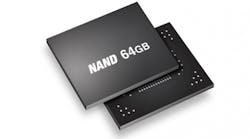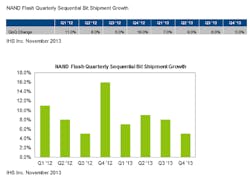Growth in the global NAND flash memory market is slowing in the second half of 2013 following diminishing demand for local data storage in smart phones and tablets, due in part to the rise of cloud-based devices, according to a new market research report from industry researcher IHS Inc.
NAND bit shipments were set to grow 8% in the third quarter according to early estimates. That’s down from 9% in the second quarter, IHS reports, and will be followed by an even lower 5% in the fourth quarter (see the figure). Fourth-quarter growth will be down sharply compared to the year-earlier period, when the market grew 16%.
“The fast-growing season for flash memory appears to be running out of momentum as density growth levels off in many of the products that are leading users of NAND,” says Ryan Chien, storage systems analyst at IHS. “Moreover, few upcoming devices are expected to increase their NAND options, further dampening growth in the short term.”
Despite the second-half slowdown, IHS is projecting a record year in both shipments and revenue for the NAND flash industry in 2013, with 39 billion gigabytes of shipments and $24 billion in revenue.
IHS points to cloud storage, growth in low-end smart phones that have limited NAND use, and consumer indifference to NAND-heavy device categories such as game consoles, PCs, e-readers, and USB drives as key reasons for the slowing market.
“Streaming media options and free cloud storage are diminishing the prospects for increased NAND usage in smart phones,” Chien says. “This is true for all three major mobile operating systems—Apple’s iOS, Google’s Android, and Microsoft’s Windows Phone. With less need to store data in local devices, the requirement for greater storage is reduced.”
NAND prices are rising despite the slowdown in usage. IHS points to a small supply chain disruption due to a fire at South Korean memory supplier SK Hynix in Wuxi on September 4. The incident caused the manufacturer to shift some of its NAND capacity to DRAM and opened the door to possible supply chain challenges down the line.
Formulated to keep track of movements in NAND pricing over time, the IHS NAND price index has jumped nearly 10% since the fire, signaling some nervousness in the market. But as demand concerns have started to weigh on the market, prices have drifted over recent weeks, according to IHS.
New Products
New NAND products continue to make their way to the market, with Toshiba America Electronic Components and Kingston Technology making news recently.
Toshiba’s new embedded NAND flash memory modules integrate NAND chips fabricated with the company’s 19-nm second-generation process technology and comply with the latest e-MMC 1 standard. Designed for application in a wide range of digital consumer products, the modules target smart phones, tablet PCs, and digital video cameras. The lineup of single-package embedded NAND flash memories includes densities from 4 to 128 Gbytes. Each device integrates a controller to manage basic control functions for NAND applications.
Kingston Technology’s SSDNow mS200 mSATA solid-state drive offers a cost-effective performance boost with dual-drive option that allows room for adding high-capacity storage. Ideal for system builders, OEMs, and enthusiasts, the mS200’s miniscule form factor is eight times smaller than a traditional 2.5-in. hard drive, making it ideal for notebooks, tablets, and ultrabooks. Available in capacities up to 120 Gbytes, the mS200 SSD has a caseless, PCB-only design with no moving parts.
NAND bit shipments will slow to 5% growth in the fourth quarter of 2013, according to IHS Inc.









